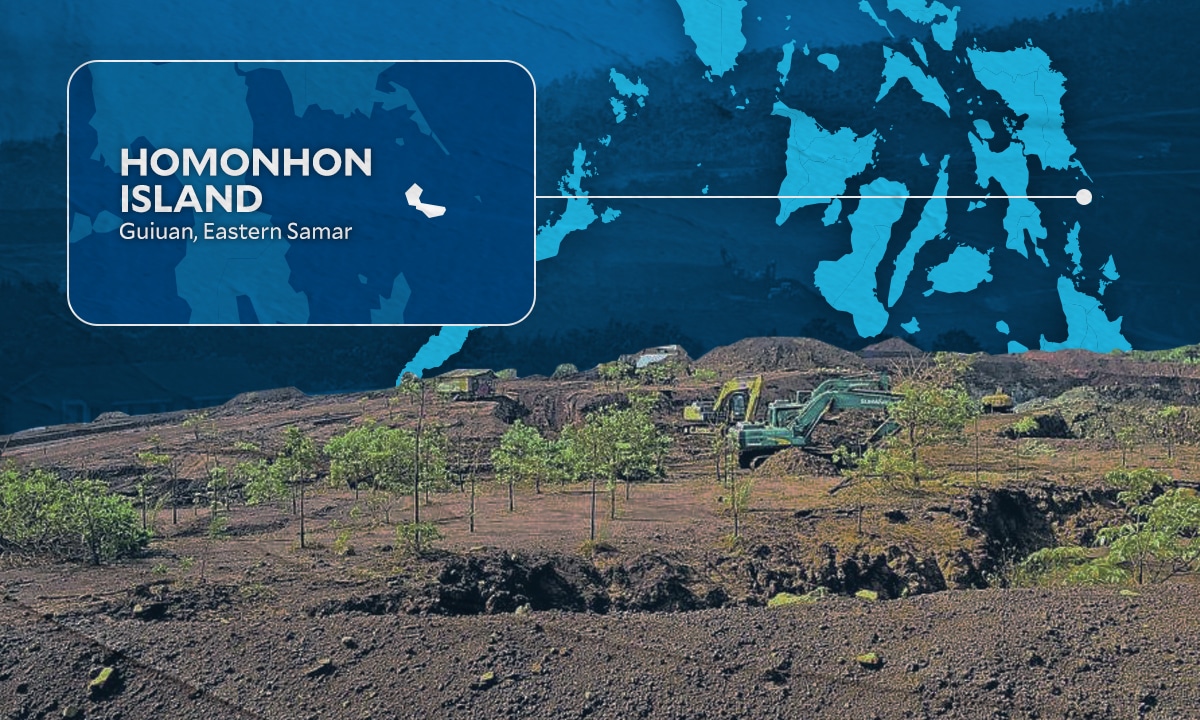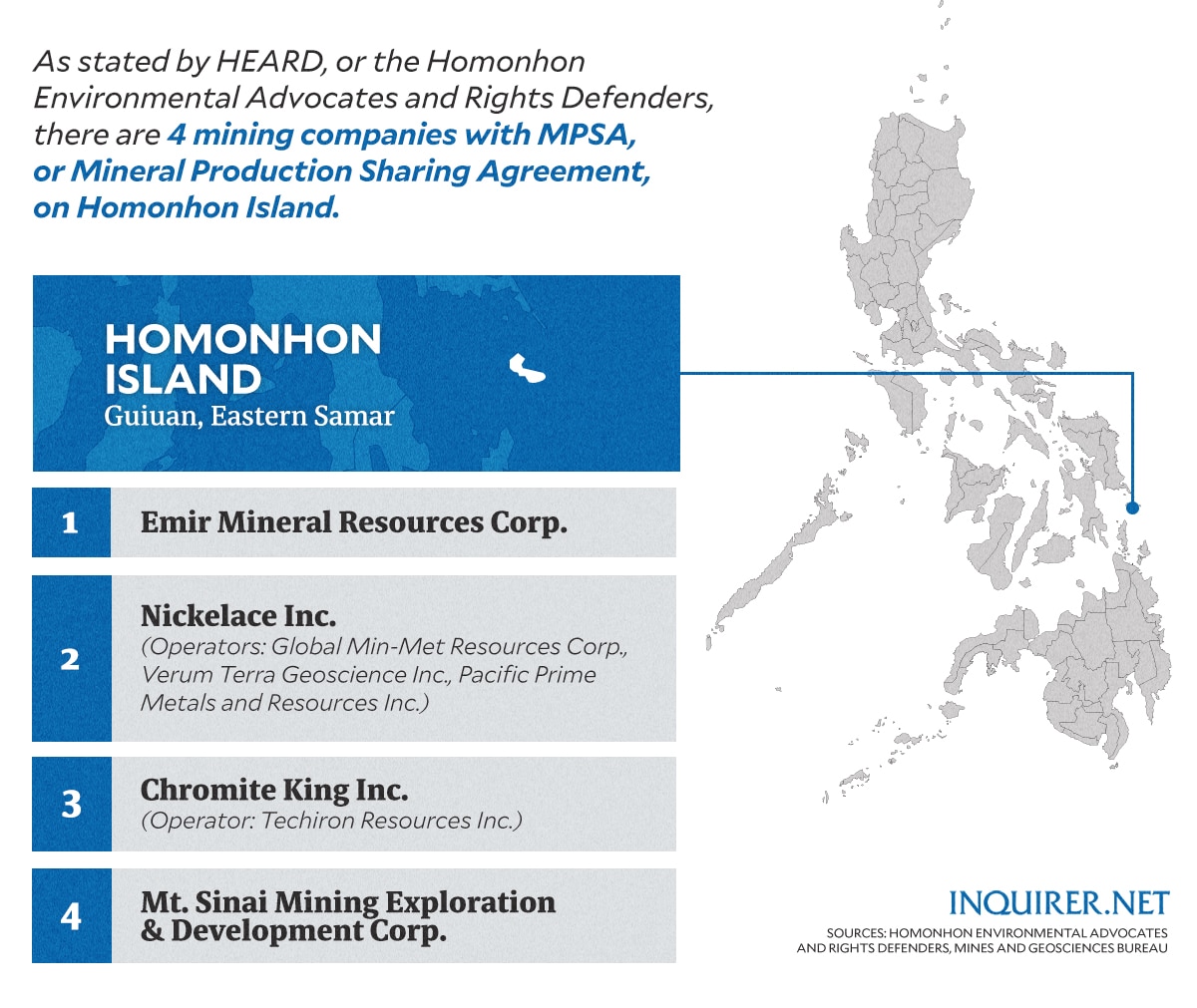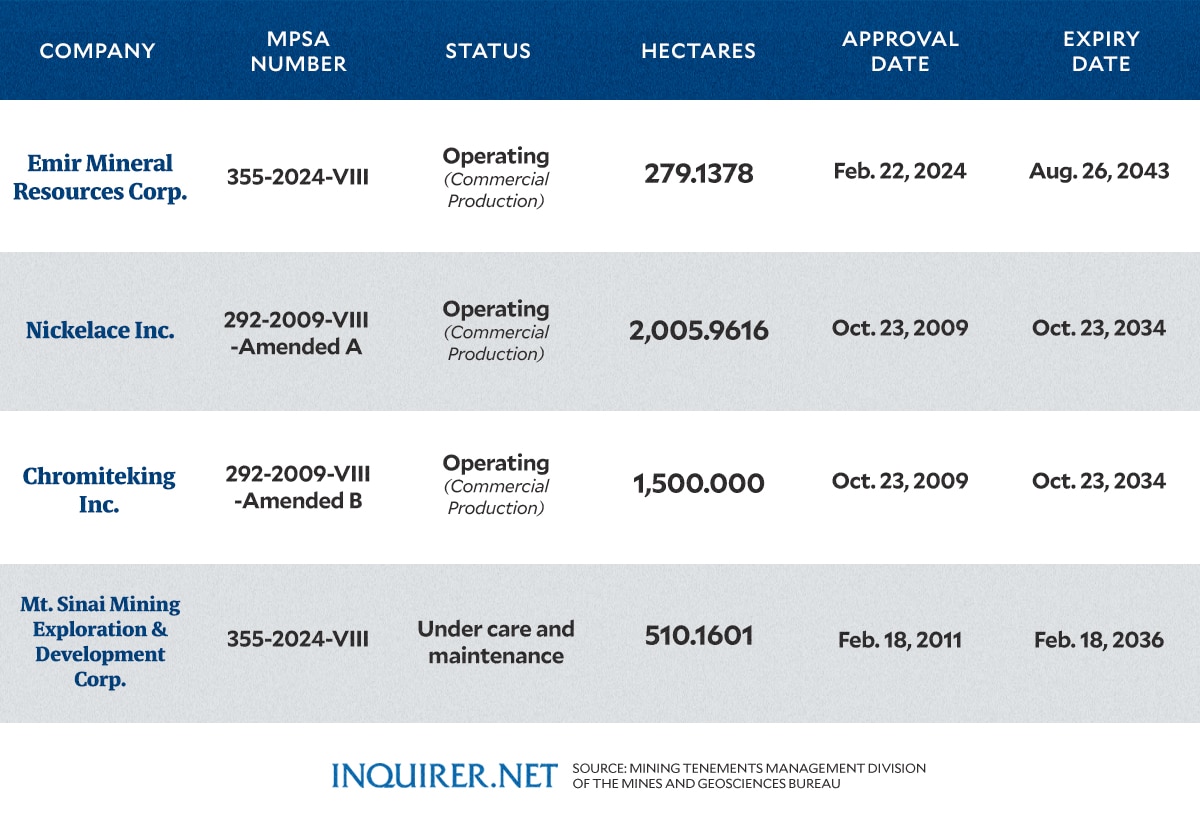MANILA, Philippines—Mining in Eastern Samar’s Homonhon Island has been so rampant that locals started asking: “Would there still be something left for our children?”
“We do not know if there would still be something left [of the island],” Carmi Macapagao, a resident of Guiuan and president of the Homonhon Environmental Advocates and Rights Defenders (Heard), said.
Since 1983, mining companies have extracted minerals from the 10,400-hectare island known for its vast deposits of nickel and chromite, which are both essential in the production of stainless steel.
Macapagao told INQUIRER.net that mining in the 1980s was only small scale, but by 2009, large scale mining started on the island where almost 5,000 individuals are residing now.
RELATED STORY: China’s appetite for PH ores gnaws at mining trade
She said that out of the eight barangays, five have active mining operations. The rest, or three barangays, have none, but there is still an approved Mineral Production Sharing Agreement (MPSA).
Miners
Based on a list by the Mining Tenements Management Division of the Mines and Geosciences Bureau, there are four mining companies with MPSAs on Homonhon Island, however, only three are “active”.
- Emir Mineral Resources Corp. (EMRC): MPSA No. 355-2024-VIII
- Nickelace Inc.: MPSA No. 292-2009-VIII-Amended A
- Chromiteking Inc.: MPSA No. 292-2009-VIII-Amended B
Mt. Sinai Mining Exploration & Development Corp. has no active operation.
The MPSA is an agreement between the government and a contractor which grants the latter the “exclusive right to conduct mining operations within the contract area.” Then in exchange, “the government is given a share in the production.”
The MGB said that Nickelace Inc. and Chromiteking Inc. have a contract area of 2,005.9616 hectares and 1,500.000 hectares, while EMRC and Mt. Sinai Mining Exploration & Development Corp. cover 279.1378 hectares and 510.1601hectares.
RELATED STORY: Is mining good or bad? Gov’t, green group take opposite sides
Macapagao, however, pointed out that some of the mining companies with MPSAs, like Nickelace Inc. and Chromiteking Inc., have “operators”:
- Nickelace Inc.
- Global Min-Met Resources Corp.
- Verum Terra Geoscience Inc.
- Pacific Prime Metals and Resources Inc.
- Chromite King Inc.
- Techiron Resources Inc.
Global Min-Met Resources Corp.’s mining operations are within the 800-hectare area of Nickelace Inc.’s contract area, while Verum Terra Geoscience Inc. and Pacific Prime Metals and Resources Inc. cover 500 hectares and 700 hectares.
Revived
Three of the companies that are mining nickel and chromite from the island had been ordered closed by the Department of Environment and Natural Resources (DENR) in 2017:
- Mt. Sinai Mining Exploration & Development Corp.
- EMRC
- Techiron Resources Inc.
EMRC, however, was one of the five companies given approval by the Office of the President in 2020 “after complying with mining laws,” a report by the Philippine Center for Investigative Journalism stated.
Then in 2018, the DENR issued a resolution partially granting Mt. Sinai Mining Exploration & Development Corp.’s motion for reconsideration. While operations were ordered suspended, it was directed to take corrective measures and pay penalties.
Taxes for PH
As stated by the MGB in Eastern Visayas, the government was paid over P182 million in excise tax in 2023 from the operations of mining companies on the island, except for Mt. Sinai Mining Exploration & Development Corp.
- EMRC: P27 million
- Nickelace Inc. P106.2 million
- Chromiteking Inc. P49 million
Based on government data, EMRC exported P1.50 million dry metric tons of nickel in 2023, while Nickelace Inc. exported 5.16 million dry metric tons. Chromiteking Inc. exported 1.60 million dry metric tons of chromite and nickel.
The MGB Eastern Visayas said that as of last year, the four companies have employed over 1,600 individuals. However, it was not made clear if those were locals of Homonhon Island.
Because of these, Guiuan mayor Annaliza Gonzales-Kwan defended the mining operations, saying that these have brought a lot of benefits not only to the government but to residents, as well.
“Poverty is the bigger problem,” she said.
Gonzales-Kwan stressed that she is for responsible mining: “I understand the issue of the environment, but if people have no jobs, the rest of the environment will be destroyed.”
READ: Eastern Samar mayor stands by mining operations on Homonhon
“We are working on a comprehensive development project for Homonhon Island which will be funded by the social development management program fund of the mining companies which is one percent of their operating cost,” she said.
Mining’s damage
But Macapagao stressed that the silence on the damage caused by mining activities is deafening, as there has been no concrete government data with regard to how mining is impacting the environment.
Last year, no less than Bishop Crispin Varquez expressed concern over the “escalated mining operations” on the island, where the Spanish expedition led by Ferdinand Magellan landed on March 16, 1521.
READ: Study mining impact on Homonhon – bishop
He then called on the government to “carefully study the mining operations in the island to ensure that these will not have devastating effects on the environment and the local residents.
“We call on our government leaders and concerned agencies to take action on this matter and to consider primarily the preservation, safety, and welfare of the affected areas and its residents,” Varquez said.
This year, the Save Homonhon Movement asked the National Historical Commission of the Philippines, too, “to take a proactive role in spearheading efforts to protect Homonhon Island from destructive mining activities.”
It said there is an imminent threat to the island’s cultural and environmental integrity: “The extraction of minerals not only irreversibly damages the fragile ecosystems but also erodes the physical traces of our past.”
READ: Historic Homonhon faces water shortage
As pointed out by Macapagao, “it has only been a few years since the start of full blown mining on the island but we are already experiencing a lack of water” as mining companies use a lot of water for mining, milling, and waste disposal.
“There is a proposal that we desalinate, but how did we reach this point when Homonhon Island is a watershed,” she said.
READ: Homonhon rising
Back in 2021, the barangay chairman of Barangay Casuguran, one of the island’s villages with active mining operations, said that “mining has stripped away 60 percent of our island’s surface.”
PCG station?
Last May, the Philippine Coast Guard (PCG) in Eastern Visayas said that it has established a station on the island to track the movements of Chinese cargo vessels directly transporting minerals to China.
However, Macapagao said there is none. This was confirmed in a call made by INQUIRER.net to the PCG in Guian, which said that there is no station on Homonhon Island, saying that it can refer the call back to PCG-Eastern Samar.
The PCG-Eastern Visayas had said that the presence of Chinese vessels in the waters off the island is legal since these are international cargo ships, but Macapagao stressed: “How can they say that it is legal when the PCG is not really there?”
READ: PCG watching Chinese cargo ships off Homonhon
“That’s why some Chinese nationals were not arrested because they were inside one of the vessels. So they cannot say that there is nothing illegal since they are not there everyday to check these vessels,” she said.
Last month, 13 Chinese nationals working for Rockstar Contract Solution Inc. and Global Min Met Mining Company were arrested for illegal mining.
“Illegal employment undermines local laws and communities. We are committed to monitoring and addressing cases like these to protect our borders and environment,” the Bureau of Immigration said.
As explained by Macapagao, most of the time, when loading and shipping operations are full blown, there are 10 to 12 cargo vessels off the island.





